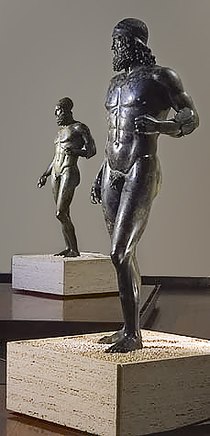Riace bronzes
 |
|
| Year | 460-450 BC |
|---|---|
| Type | Bronze Sculptures |
| Location | Museo Nazionale della Magna Grecia, Reggio Calabria, Italy |
The Riace bronzes (Italian Bronzi di Riace [ˈbrondzi di riˈaːtʃe]), also called the Riace Warriors, are two full-size Greek bronzes of naked bearded warriors, cast about 460–450 BC that were found in the sea near Riace in 1972. The bronzes are currently located at the Museo Nazionale della Magna Grecia in the southern Italian city of Reggio Calabria, Italy.
They are two of the few surviving full-size ancient Greek bronzes (which were usually melted down in later times), and as such demonstrate the superb technical craftsmanship and exquisite artistic features that were achieved at this time.
The bronzes are on display inside a microclimate room on top of an anti-seismic Carrara marbled platform. Along with the bronzes, the room also contains two head sculptures: “la Testa del Filosofo” and “la Testa di Basilea”, which are also from the 5th century BC.
Although the bronzes were rediscovered in 1972, they did not emerge from conservation until 1981. Their public display in Florence and Rome was the cultural event of that year in Italy, providing the cover story for numerous magazines. Now considered one of the symbols of Calabria, the bronzes were commemorated by a pair of Italian postage stamps and have also been widely reproduced.
The two bronze sculptures are simply known as “Statue A”, referring to the one portraying a younger warrior, and “Statue B”, indicating the more mature-looking of the two. Statue A is 203 centimetres tall while Statue B stands 196.5 centimetres tall.
Stefano Mariottini, then a chemist from Rome, chanced upon the bronzes while snorkeling near the end of a vacation at Monasterace. While diving some 200 metres from the coast of Riace, at a depth of six to eight metres, Mariottini noticed the left arm of statue A emerging from the sand. At first he thought he had found a dead human body, but on touching the arm he realized it was a bronze arm. Mariottini began to push the sand away from the rest of statue A. Later, he noticed the presence of another bronze nearby and decided to call the police. One week later, on August 21, statue B was taken out of the water, and two days after that it was the turn of statue A. No associated wreck site has been identified, but in the immediate locality, which is a subsiding coast, architectural remains have also been found.
...
Wikipedia
